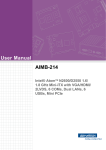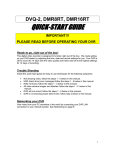Download User Manual
Transcript
13 User Manual Please read the instructions thoroughly before operation and retain this manual for future reference. 733_Manual_V1.1 IMPORTANT SAFEGUARD CAUTION RISK OF ELECTRIC SHOCK CAUTION: To reduce the risk of electric shock, do not expose this apparatus to rain or moisture. Only operate this apparatus from the type of power source indicated on the label. The company shall not be liable for any damages arising out of any improper use, even if we have been advised of the possibility of such damages. The lightning flash with arrowhead symbol, within an equilateral triangle, is intended to alert the user to the presence of uninsulated “dangerous voltage” within the product’s enclosure that may be of sufficient magnitude to constitute a risk of electric shock to persons. This exclamation point within an equilateral triangle is intended to alert the user to the presence of important operating and maintenance (servicing) instructions in the literature accompanying the appliance. CE Mark This apparatus is manufactured to comply with the radio interference. The company does not warrant that this manual will be uninterrupted or error-free. We reserve the right to revise or remove any content in this manual at any time. Firmware BootLoader: 0.1.0.0 Kernel: 0.1.2.9 HtmlFile: 0.1.2.2 Mpeg4: 0.1.0.5 Application: 0.1.3.4 TABLE OF CONTENTS 1. PARTS AND FEATURES ---------------------------------------------------------------------------1.1 OVERVIEW ---------------------------------------------------------------------------------------1.2 FEATURES----------------------------------------------------------------------------------------1.3 SPECIFICATION ---------------------------------------------------------------------------------1.4 PACKAGE CONTENT --------------------------------------------------------------------------1.5 PANEL ----------------------------------------------------------------------------------------------- 1 1 1 2 3 3 2. INSTALLATION AND CONNECTION ------------------------------------------------------------ 5 2.1 SYSTEM CONNECTION ----------------------------------------------------------------------- 5 2.2 APPLICATION DIAGRAM ---------------------------------------------------------------------- 5 2.3 CONNECTION CONFIGURATION----------------------------------------------------------- 6 2.4 SOFTWARE INSTALLATION ------------------------------------------------------------------ 7 2.5 IP SETTING AND LAN CONNECTION ----------------------------------------------------- 7 2.6 CONNECTION VIA INTERNET -------------------------------------------------------------- 10 3. OPERATION GUIDE --------------------------------------------------------------------------------- 11 3.1 SOFTWARE OPERATION -------------------------------------------------------------------- 11 3.1.1 Login AP Icon Explanation-------------------------------------------------------------- 11 3.1.2 Basic Operation --------------------------------------------------------------------------- 12 3.2 PLAYBACK OPERATION---------------------------------------------------------------------- 15 3.3 SYSTEM CONFIGURATION------------------------------------------------------------------ 17 3.3.1 Network-------------------------------------------------------------------------------------- 17 (1) DDNS ------------------------------------------------------------------------------------ 18 (2) SNTP ------------------------------------------------------------------------------------- 19 (3) FTP --------------------------------------------------------------------------------------- 19 (4) Mail --------------------------------------------------------------------------------------- 20 3.3.2 General -------------------------------------------------------------------------------------- 20 (1) Peripheral ------------------------------------------------------------------------------- 21 (2) Account ---------------------------------------------------------------------------------- 21 (3) File Path --------------------------------------------------------------------------------- 23 (4) Schedule Record ---------------------------------------------------------------------- 24 (5) Trigger------------------------------------------------------------------------------------ 24 3.3.3 Information---------------------------------------------------------------------------------- 26 (1) Log File ---------------------------------------------------------------------------------- 26 (2) Event Record List --------------------------------------------------------------------- 27 3.4 OPERATION VIA IE WEB BROWSER ----------------------------------------------------- 27 APPENDIX 1 - DVR PIN CONNECTION----------------------------------------------------------- 29 APPENDIX 2 - PTZ PIN CONNECTION ----------------------------------------------------------- 32 APPENDIX 3 - DDNS APPLY ------------------------------------------------------------------------- 33 1. PARTS AND FEATURES 1.1 OVERVIEW With this video web server, you can monitor your security cameras over the Internet or LAN. No PC is required. Just plug the camera and RJ45 networking cable to this device, and you can monitor the live view through Internet or LAN with the licensed software AP or IE web browser. MPEG-4 compression format makes the transmission faster for real-time video stream. 1.2 FEATURES Support MPEG4 compression format for real-time video stream Compression format (MPEG4 / JPEG) is selectable for different network bandwidth and applications Support video / audio recording Support alarm / motion-trigger recording Adjustable motion detection sensitivity Whenever alarm system triggered, video streaming or pictures will be uploaded over FTP / email as an instant notification. Support TCP/IP, PPPoE, DDNS and DHCP for network connection Support DDNS and function as a router Support NTSC system / PAL system / auto detection of video input signals Support video access by AP (software) or HTML page (IE Explorer) Full event record list for easy search and quick playback Support schedule recording Support multiple user access levels with security protection Support multiple on-line users (up to 10 users) Support watermark function Support de-blocking and de-interlace functions Support watch dog function for automatic network reconnection ANR will reactivate recording function automatically when the network is reconnected Easy to upgrade firmware 1 1.3 SPECIFICATION MPEG-4 Video Web Server Video Input 1 channel for analog & digital products, 1.0 Vp-p 75 composite, BNC Audio Input 1 channel audio input Alarm Input 2 inputs / 1 output Watch dog Yes RS-485 Port Yes Ethernet (10/100 Base-T) Network Interface MPEG4 / JPEG Image Compression Video Adjustment Network Connection Brightness, Contrast, Saturation and Hue Support TCP/IP, PPPoE, DDNS and DHCP for network connection Protocols TCP/IP, ICMP, SMTP, FTP, HTTP, DHCP, DDNS, PPPoE, SNTP Resolution 704x480, 352x240 (NTSC) / 704x576, 352x288 (PAL) Performance Video through put: Up to 30(NTSC), 25(PAL) frames/ second Motion Trigger Recording Yes Motion Detection 3 adjustable factors Trigger & Action Triggered by GPIO Input, Action: E-mail video/images or video/images upload to FTP site's specific accounts Watermark Yes De-blocking Yes De-interlace Yes Password protection Security Power Source DC 12V Current consumption 500 mA * The specification is subject to change without notice. 2 1.4 PACKAGE CONTENT Video Web Server x 1 Licensed Software AP x 1 Crossover LAN cable x 1 Adapter x 1 DSUB Connector x 1 User Manual & Quick Start x 1 NOTE: Please check and make sure the above items are included in the sales package. 1.5 PANEL The description for back panel connectors is as follows: 1. LAN Connect the Video Web Server to the Internet or LAN with a cable, or connect directly to PC with a standard pass-through cable. 2. VIDEO INPUT (1 channel) Connect to a video source, such as the camera or DVR video output. 3. AUDIO INPUT (1 channel) Connect to an audio source, such as the camera audio output. 4. ALARM I/O (optional for advanced applications) Connect to control devices, such as the PTZ camera, DVR or external alarm signal input. 3 5. POWER Plug in the supplied power adaptor (12V / 500mA). 6. RESET (at the bottom of Video Web Server) Press this button to restore default settings. 4 2. INSTALLATION AND CONNECTION 2.1 SYSTEM CONNECTION 1. Power Connect to a DC 12V regulated adapter. 2. Video and Audio Input Connect video and audio outputs of the camera or DVR…etc. Take DVR as an example, after connection, set the baud rate and ID of the DVR. Make sure that the baud rate and ID are the same as the settings of the video web server. 3. Software Installation Install the software on PC. 4. IP Setting Connect the video web server to your PC for IP setting (Local Connection). 5. LAN After IP setting, connect the video web server to Internet with ADSL or CABLE MODEM. 6. ALARM I/O (Optional for advanced applications) Connect to control devices, such as the PTZ camera, DVR or external alarm signal input. 2.2 APPLICATION DIAGRAM The diagram below illustrates the applications of the video web server. 5 2.3 CONNECTION CONFIGURATION 1. DVR Baud Rate and ID Setting Set the baud rate and ID of the DVR. Make sure that the baud rate and ID are the same as the settings of the video web server. 2. DVR and Video Web Server PIN Connection (Optional for advanced application) Connect DVR PIN with VIDEO WEB SERVER PIN. For detailed PIN connection, please refer to “APPENDIX 1 - DVR PIN CONNECTION” and “APPENDIX 2 - PTZ PIN CONNECTION” PIN Function Description 1, 6 RS485-A, RS485-B Use RS485-A & RS485-B serial communication signals to control digital units just like that to control DVR. 4, 9 ALARM INPUT Use PIN 4, 9 to receive the alarm input and then trigger the video web server to send mails to users for auto e-mail warning system. 5 GND Ground 2, 3 NORMAL Use PIN 2 or 3 to trigger the external device to act. Please see the example above for 1CH/4CH DVR. It’s recommended to solder these joints. Attention: The voltage restriction is under DC24V 1A. 6 2.4 SOFTWARE INSTALLATION 1. Place the attached CD into your CD-ROM drive, and it will start to install the licensed software AP program into your PC. 2. Click “ ” twice to start the program installation. 3. Follow the on-screen instructions to finish the installation process. 4. Click “Finish” button to complete the installation. Then, the icon “ ” will appear on the desktop. NOTE: After the physical connection, please go to the next two sections for IP address setting. 2.5 IP SETTING AND LAN CONNECTION 1. Network setting for PC. NOTE: The following instructions are based on Windows XP O/S. If the O/S is Windows 2000, the setup procedure is similar to that on Windows XP O/S. a) Go to “Start” “Control Panel” “Network and Internet Connections” “Network Connections” “Local Area Connection Status”. b) Choose “General” tab, and select “Internet Protocol (TCP/IP). c) Click “Properties” to go into “Internet Protocol (TCP/IP) Properties” window. Select “General” tab for IP setting. NOTE: Before changing the network setting, please write down the original values in case you may need to restore the setting. 7 Click on “Use the following IP address”, and enter the IP address and subnet mask. The IP address should be like 192.168.1.XXX, where XXX can be any number from 1 to 254 (except 10 because 192.168.1.10 is the default IP address of this video web server). The subnet mask is always 255.255.255.0. 2. After PC network setting, connect your PC or notebook to the video web server with a crossover LAN cable. NOTE: In some operation environments, users might need the standard CAT5 cable. 3. To configure the server IP address, click “ ” twice to enter the licensed software AP login page. 4. Key in your user name, password, server IP address, and port number. Then, click the green button to connect. NOTE: By default, the user name and password are both “admin”, the server IP address is IP 192.168.1.10, and the port number is 80. 8 5. When you see a similar screen as the following one, it means you’re successfully logged in the program of the video web server. 6. Click “ ” (System Config), and select “General” “Peripheral” to set the baud rate, ID and model which users want to remotely control later. Press “APPLY” to enable the changes. The settings of “Baud rate” and “ID” should be the same as the setting of the external device users want to remotely control. 7. Click “Network” to set the server IP address, gateway and net mask provided by your local ISP (Internet service provider), as well as the web server, stream port and IP type. Press “APPLY” to enable the changes. Static IP 9 Dynamic IP NOTE: For the dynamic IP (PPPoE, DHCP), users need to apply “Host Name” first. Please refer to “APPENDIX 3 DDNS APPLY”. 8. Disconnect PC and the video web server, and then connect the video web server to the Internet with a RJ-45 line. 2.6 CONNECTION VIA INTERNET 1. Restore the network setting of your PC to the original one, and connect the PC to the Internet. (Since the PC IP address has been changed in the previous section, it must be restored to the original setting for Internet connection). 2. Click “ ” twice, and enter your user name, password, static IP address and port number. Then, click the green button to connect. Static IP: Dynamic IP: NOTE: The default user name and password are both “admin”. 10 3. OPERATION GUIDE 3.1 SOFTWARE OPERATION After the physical connection and network setting of the video web server, please following the illustrations in this section for software operation. 1. Click “ ” twice to enter the login page. 2. Key in “User Name”, “ Password”, and “Server IP” (Static IP) or “Host name”(Dynamic IP). Click the green button to connect. 3.1.1 Login AP Icon Explanation The AP login icon explanations are as following: Icon Function Description Address Book Press this button to add a new IP address into the IP address book, or choose any preset IP address to access the software AP software. Search Search available DVR IP addresses in the local area network and modify the network setting of the DVR. Player Press this button to access and play the latest recorded file that is saved in your PC. Copy Press this button to copy all the software installation files, so users can keep all the settings of the video web server for next software installation on other PCs. 11 Icon Function Description Upgrade Firmware Press this button to upgrade DVR firmware or OSD language files. The provided firmware and OSD files should be saved at PC first. Login Setting Users could press this button to set the transmission type (UDP or TCP) and decode type (MPEG4 or JPEG). NOTE: The version of the licensed software AP will be shown on the login page. 3.1.2 Basic Operation DVR Control Panel The illustration below takes 4CH DVR as an example. NO. Function Description a Image transfer rate per second b Data transfer rate c Video only / Audio only / Both Video and Audio d Connect / Disconnect Press to connect to / disconnect from the DVR. 12 NO. Function Description e Image adjusting f Brightness / Contrast / Saturation / Hue Press this button to take a snapshot of the image which will be Snapshot saved in the designated destination. g Press this button to start recording, and press this button again to Record stop recording. The recorded files will be saved to the specified path on the PC. Each recorded file can be up to 18,000 frames. When the recorded file is full, a new-recorded file will be saved as the second file. If the HDD space is less than 200MB, the program will stop recording. h Press this button to enter the setting page of the licensed System Config software AP. i Number of online users Show the current online user(s). j CH 1 ~ 4 Press to switch to a single channel you want to see. k PIP/+, QUAD/- l Stop / Fast Rewind / Slow Playback / m Fast Forward / Pause / Play Digital zoom in/out Zoom n Press this button to enable the key lock function of the DVR. Lock o Record The recorded data will be saved in the DVR HDD. Search Press this button to enter the DVR search menu. p q Menu / Up / Down / Left / Right r Enter Press this button to confirm the settings or enter your selection. s TURBO To speed up menu selection or PTZ camera control at AP side, users can activate "Turbo" function by clicking this button. Users are allowed to change the turbo steps from 1 to 10. Ex. If users activate the TURBO function and set the turbo step to "3", one-mouse click will be as three-mouse click when users press one of the button up/down/left/right. 13 PTZ Control Panel NO. Function a~i j Description The same as DVR control panel. Preset 1 ~ 16 A preset position is a pre-defined camera view that can quickly and easily been viewed. k AUTO Press this button to enter the auto pan or sequence mode (depend on the setting in the PTZ menu). In the auto pan mode, the Live View page will rotate through the selected preset positions, in a set order or in sequence. In the sequence mode, the Live View page will automatically display the view from preset positions in a set order at set intervals. l Pan Press to enable/disable the panning function. m Zoom Tele n Zoom Wide 14 NO. Function Description o Focus Near p Focus Far q Max Zoom In r Max Zoom Out s Menu / t Up / Enter Down / Left / Right Press this button to confirm the settings or enter your selection. u TURBO To speed up menu selection or PTZ camera control at AP side, users can activate "Turbo" function by clicking this button. Users are allowed to change the turbo steps from 1 to 10. Ex. If users activate the TURBO function and set the turbo step to "3", one-mouse click will be as three-mouse click when users press one of the button up/down/left/right. NOTE: For Hot Point function, users can control our own brand PTZ camera screen to a specific point by moving the cursor. 3.2 PLAYBACK OPERATION Find a recorded file in the PC, and double click on it for playback. NO. Function Description a Playback Information Display the information, such as “Date”, “Time”, “Resolution”, “Rewind / Forward Speed”, “Status” and “Functions”, etc. b Time Progress Bar Show the playback progress status. 15 NO. Function c Functions: Description De-interlace Reduce the vibration of the paused picture. De-blocking Reduce the video mosaic phenomenon. OSD Display the OSD of the AP playback window. AVI convert Convert the entire recorded file to AVI format. Config. Setting Enter AP configuration setting box, and set the file path, text color, and text color of progress status. * Mute: Play the video only (without audio). * AV sync.: Play with the audio and video synchronously. Watermark Proof the authenticity of the backup video. In the playback mode of the software AP, you can press this button to check the authenticity of the BACKUP VIDEO. If the BACKUP VIDEO had been altered, the video image will turn to light red and the playback will be paused. Open Previous File Open the previous backup video. When users pause the playback, press this button to go to the previous frame. Open Next File d Playback Control Buttons Play / Stop / Pause / Fast Rewind / Fast Forward Snapshot Press this button to take a snapshot of the current image which will be saved in the specified destination. e f Open the next backup video. When users pause the playback, press this button to go to the next frame. Close the Player Note: When users use remote AP manual recording, the watermark function is not supported. 16 Convert the recorded file to AVI format The backup file can be played directly in your PC via the supplied licensed software AP, or via other media players (Ex: Windows Media Player or RealPlayer) after the file is converted to “AVI” format. To convert the entire recorded file to AVI format, press button. To snap a video clip, right-click the mouse to set a starting point (▲ red) and click one more time to set an ending point (▲ green). Then, right-click the mouse to convert to AVI format. 3.3 SYSTEM CONFIGURATION Press “ ” (System Config) button to enter the “System Config” page. In this page, users can select the different functions for advanced setup. After setup, press “APPLY” button to save the settings. 3.3.1 Network Click “Network”, and make the following settings as needed. 1) IP TYPE: Choose one IP type from Static IP / PPPOE / DHCP. ‧ Static IP Please refer to “2.5 IP SETTING AND LAN CONNECTION” at page 7. 17 ‧ PPPOE and DHCP Please refer to “2.5 IP SETTING AND LAN CONNECTION” at page 7. 2) Web Port: The port to send commends. The port number should be the same as the DVR port number. The default value is 80. 3) Stream Port: The port to transmit video and audio. The default value is 9000. NOTE: If the video web server is connected to a router, always turn on both TCP and UDP services for the web port and stream port on the router for the video web server to function normally. (1) DDNS You need to apply a DDNS account before setting PPPOE or DHCP connection. DDNS is a service for transforming the dynamic IP corresponding to a specific “Hostname”. Go to a website which provide free DDNS services and apply a “Hostname”. For DDNS service application, please refer to “APPENDIX 3 - DDNS APPLY” at page 33. ‧ Enable DDNS Function: a. b. c. d. e. DDNS: Choose “Enable”. User Name: Type your DDNS account. Password: Type your DDNS password. Domain: Type the “Host Name” you applied previously (EX: hostname.dyndns.org). System Name: Choose the DDNS server where you applied the domain name (EX: dyndns). 18 (2) SNTP SNTP (Simple Network Time Protocol) is for time setting. So it is also related to “Schedule Record” in “General”. ‧ GMT (Greenwich Mean Time) Once users choose the time zone, the video web server will adjust the local area time of the system automatically. ‧ Server Name Users can simply use the automatic SNTP server (Automatic), or set another SNTP server (Manual). ‧ Sync Server Time The video web server will synchronize the time with the network time. NOTE: This product does not have RTC, so it needs to get time from the Internet. (3) FTP When an alarm is triggered, the video web server will capture the instant pictures and upload them to the assigned FTP site. NOTE: To get an alarm notification at the FTP site when an alarm is triggered, users must enable the function of FTP notification in “General” “Trigger”. 19 (4) Mail When an alarm is triggered, the video web server will capture and email the instant pictures (10 JPEG pictures max) or MPEG-4 film (3 seconds max) to the assigned recipients. NOTE: To get an alarm mail when a motion is triggered, users must enable the function of Email notification in “General” “Trigger”. ‧ SMTP Server: Enter the SMTP server address provided from your e-mail system supplier. ‧ Mail from: Enter the entire mail address to ensure mails will not be blocked by some SMTP servers. Users can add the email addresses in “Modify alarm email address”. ‧ Verify Password: If the mail server requires password verification, enter the user name and password. 3.3.2 General Users can set video-related settings here. ‧ Video System: NTSC / PAL / AUTO ‧ Video Type: MPEG4 (Only) / MPEG4 / JPEG 20 ‧ Resolution: MPEG 4 (D1), JPEG (D1), Frame / MPEG4 (D1), JPEG (CIF), Frame MPEG 4 (CIF), JPEG (CIF), Frame / MPEG 4 (CIF), JPEG (CIF), Field NOTE: D1 represents 704 x 480 (NTSC) / 704 x 576 (PAL); CIF represents 352 x 240 (NTSC) / 352 x 288 (PAL) ‧ Quality: Basic / Normal / High / Best ‧ Bitrate: Max / 3000 kbps / 2000 kbps / 1000 kbps / 640 kbps / 512 kbps / 256 kbps ‧ De-blocking: Check this option to soften the edges of the images, but it will consume more CPU resources. (1) Peripheral Users can set the settings for the connected video output device here. ‧ Model: Choose a proper device type for the connected video output device: Camera / 1CH DVR / 4CH DVR (FULL) / 4CH DVR (BASIC) / 4CH DMR / 9CH DMR / 16CH DMR / 4 CH DQR / PTZ / 4 CH MPEG 2 DVR / PTZ PELCO D. ‧ Baud Rate: Set the baud rate for the connected device (2400, 4800, 9600, 19200, 38400, 57600, 115200). ‧ ID: Set the ID number (0 ~ 255) for the connected device. Turbo Step: To speed up menu selection or the control of the PTZ camera under AP operations, users can activate "Turbo" function by selecting from the drop-down menu. Users are allowed to change the turbo steps from 1 to 10. (2) Account You can view the current user account information, set the maximum user number, and add / delete / edit user accounts. 21 ‧ To set the maximum user number, key in the number from 1 ~ 10 in “Max User(s)”. ‧ To create a new account, press “ADD”, and you will see the setting window as the following: Item Description Username Set a user name what will be used at AP login page. Password Set a password what will be used at AP login page. Life time Select how long this account is allowed to stay online (1 Min / 5 Min / 10 Min / 1 Hour / 1 Day / INFINITY). User level Set the security level of an account. Each level has different permissions for the following functions: a b c d e f ‧ SUPERVISOR – Control all the functions. ‧ HIGH – Control all the functions except “c” & “f”. ‧ NORMAL – Control only “b”, “d” and “e” functions. ‧ GUEST – Only “b” function can be used. This level is only allowed to watch the live view. For the function description, please refer to the section “3.1.2 Basic Operation” at page 12. To confirm account creation, press “APPLY”; to discard the creation, press “EXIT”. NOTE: If the number of current accounts already reaches the maximum number, you will not be able to create an account unless any account is removed. 22 ‧ To edit an account, select one current account you want to modify, and press “EDIT”. You will see the following screen: Modify the setting you want to change. To confirm the modification, press “OK”; to discard the modification, press “EXIT”. ‧ To delete an account, select one current account you want to remove, and press “DELETE”. The selected account will be removed and this operation cannot be recovered. (3) File Path Users can view and change the file path for saving snapshots and recorded data here. ‧ Record Path: Assign the route for recorded files. ‧ Snapshot Path: Assign the route for snapshot images. 23 (4) Schedule Record Users can schedule up to 10 sets of time for recording. Click “Add” button, and add time setting preference. NOTE: The time of the schedule record is based on the PC time, not the time in the video web server. (5) Trigger ‧ Alarm: Enable or disable Email / FTP notification function. ‧ Motion: Enable or disable Email / FTP notification function. ‧ Duration: Users can set the alarm or motion duration time for 3 sec., 15 sec., 30 sec., 1 min., or 30 min. ‧ Notify Method: Email / FTP / None. ‧ Video Type: Users can choose MPEG4 or JPEG for the preferred video type. ‧ Total: When the MPEG4 video type is selected, users can select the notification file to be 1-3 seconds. When the JPEG video type is selected, users can select the notification file to be 1-10 pictures. 24 ‧ Motion Setup: ‧ Motion Area: Users can set the motion detection area here. The pink area means the area is not under detection. ‧ Motion Sensitivity: Users can set detection sensitivity factors manually (Manual), or by choosing different level (Lower, Low, Normal, High, Higher). Parameter Description NS Motion detection sensitivity (using motion estimation algorithm). The smaller the value, the more sensitive the detection will be. LS ”LS” is to set the sensitivity of comparing two different images. The smaller the value is, the higher the sensitivity for motion detection. SS ”SS” is to set the sensitivity for detecting the size of one object (the number of the grids) on the screen. The smaller the value is, the higher the sensitivity for motion detection. SENSITIVITY Users can choose different sensitivity level of motion detection, or choose “Manual” to manually set the value of sensitivity factors. Trigger Refresh: Clean the alarm message “ Icon (red) Meaning ” which is shown on the screen. Icon An alarm event is triggered. (red) After alarm duration, the red alarm (blue) message will turn to blue. A motion event is triggered. After motion duration, the red (blue) 25 Meaning motion message will turn to blue. 3.3.3 Information Users can view the information for all the online users here (Name/ IP Address / Level / Media Type). To update the online user information, press “Info Refresh” button. (1) Log File Users can view all the log information here. ‧ To show all the log information, press “Server Log” button. You can filter log types you want to see by checking or unchecking the log types on the right side. ‧ To clear all the log information, press “Erase” button. ‧ To set the maximum log items to be seen here, enter a number from 1 ~ 2047 in “MAX” LOG LIST”. 26 (2) Event Record List It’s a database, which precisely lists all alarm- / motion-triggered events, with the IP address of the video web server, event time, and number of frames. ‧ Users can directly play / delete / clear all event recording with ease by pressing “Play” / “Delete” / “Delete” / “Clear All” button. ‧ To update the record list, click “Refresh” button. All the recorded files will be listed systematically for easy search. 3.4 OPERATION VIA IE WEB BROWSER You can view the images or control the connected video output device over the network with IE web browser. Please install the licensed software AP first. Note: The supported PC operation systems are Windows 2000 and Windows XP. Follow the steps below: 1) Key in the IP address used by your video web server in the URL address box, such as 60.121.46.236, and press Enter. You will see the following page. If the port number used by your video web server is NOT 80, you need to key in the port number additionally. The format is IP address:port num, such as 60.121.46.236:888. 27 2) Check if you already installed the supplied licensed software AP. If no, click “Download AP” and install the AP. 3) Enter the user name and password, the same as the ones used at AP login. Press “Submit” when the user name and password are correct, or “Reset” to re-enter the user name and password. NOTE: For the stable network with high bandwidth, choose “TCP”; for the unstable network with lower bandwidth, choose “UDP”. 4) You will see a similar screen as the following when the login information is correct. All the buttons and their functions on the control panel are the same as the ones on AP control panel except for the buttons indicated above. Image Position Setting: Button Position LT LD Center RT RD Upper Left Lower Left Center Upper Right Lower Right For the information of other buttons, please refer to the section “3.1.2 Basic Operation” at page 12. 28 APPENDIX 1 - DVR PIN CONNECTION 1. Connect the DSUB connector supplied with the video web server to the DVR. NOTE: For detailed DVR PIN description, please refer to your DVR user manual. 29 PIN CONFIGURATION 4CH DVR 8CH / 9CH / 16CH DVR PIN FUNCTION PIN FUNCTION 1 RS232-TX 1 GND 2 RS232-RX 2~9 ALARM INPUT 3~6 ALARM INPUT 10 PIN OFF 7 EXTERNAL ALARM NC 11 TXD232 8 EXTERNAL ALARM NO 12 RS485-A 9 GBD 13 EXTERNAL ALARM NO 10 RS485-B 14 PIN OFF 11 RS485-A 15 ~ 22 ALARM INPUT 12 ~ 13 PIN OFF 23 RXD232 14 ALARM RESET 24 RS485-B 15 EXTERNAL ALARM COM 25 EXTERNAL ALARM COM 2. Go to “MENU” “ADVANCE” “SYSTEM” in your DVR, and set the following items (take 4CH DVR as an example): SERIAL TYPE: RS-485 BAUD RATE: selectable, but need to be the same as the “Baud Rate” setting in “System Config” “General” “Peripheral” of the licensed software AP. HOST ID: selectable, but need to be the same as the “ID” setting in “System Config” “General” “Peripheral” of the licensed software AP. ADVANCE SYSTEM CAMERA SERIAL TYPE RS-485 DETECTION BAUD RATE 02400 DISPLAY HOST ID 001 ALERT PASSWORD SETUP REMOTE RESET DEFAULT RESET SYSTEM CLEAR HDD EXT 003 NETWORK UPGRADE NO BACKUP AUTO KEYLOCK NEVER HDD INFO LANGUAGE ENGLISH EVENT LOG VERSION 1088-10-K2-04-AA-11 VIDEO FORMAT NTSC 30 3. Go to “General” “Peripheral” in “System Config” of the video web server. Be sure the “Baud Rate” and “ID” settings are the same as those in your DVR. 31 APPENDIX 2 - PTZ PIN CONNECTION 1. Connect the DSUB connector of the video web server to our own brand PTZ camera. 2. Go to “System Config” “General” “Peripheral” in the licensed software AP, and choose “PTZ” in “Model” drop-down list. NOTE: Set the ID as the PTZ ID value. The default value is “0”. 32 APPENDIX 3 - DDNS APPLY You need to apply a DDNS account before setting PPPoE or DHCP connection. DDNS is a service for transforming the dynamic IP corresponding to a specific “Hostname”. For DDNS setup, please refer to the steps below. ‧ Go to a website which provides free DDNS services and apply a “Hostname”. For example, go to http://www.dyndns.com. ‧ Enter all the information necessary for signing up an account according to the website instructions. 33 ‧ Then, you will see the screen “Account Created”, and Dyndns will email the instructions to your specified E-mail address for enabling your account. You must complete the procedure according to the instructions in the mail. That is to must visit the confirmation address within 48 hours of the time that the e-mail was sent to complete the account creation process. Then, you will see “Account Confirmed”. Your account is created successfully now. 34 ‧ Log in with your account information and click ”My Service”. ‧ Click ”Add Host Services”. ‧ Click ”Add Dynamic DNS Host”. 35 ‧ Fill in and choose the desired host name. ‧ The host name is created. You will be connected to the corresponding IP address whenever you enter this hostname. 36
















































